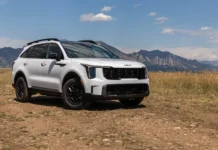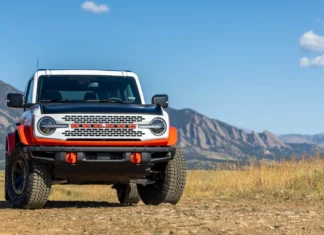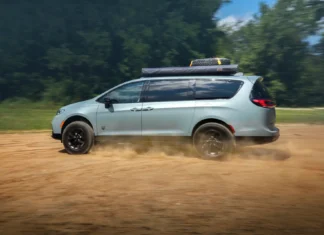Porsche Cayman has been referred to as the “starter Porsche.” A bit lower in power than the base 911 Carrera and lower in price, it’s easy to think of the 2014 Porsche Cayman S as the baby of the Porsche family.
Well, slap a bib on me and feed me some Cheerios because this “Baby Porsche” is one hell of a driver’s car. I was lucky enough to spend a week in the 2014 Cayman S. There was city driving, a few long highway stints, and the obligatory mountain twisty. It surpassed every expectation.
| STATS | Starting Retail Price | As Tested Price | HP / Lb-Ft |
| 2014 Porsche Cayman S | $63,800 | $88,625 | 325 / 272 |
| EPA Rating MPG | As Tested MPG | ||
| Rating: BUY IT! | 20 / 28 | n/a |
The 2014 Cayman S offers up 3.4L flat 6 cylinder engine, knocking out 325 horsepower and 272 lb/ft of torque. My test model was fortunately equipped with the optional Sport Chrono package and a 6 speed manual transmission. The PDK 7-speed dual clutch transmission is also available. 60 mph comes in 4.7 seconds, a smidge slower than in the PDK, at 4.6 seconds (4.4 if you use the Launch Control feature). Top speed in the manual is 175 mph, while the PDK can reach 174 mph.
Even with the slower 0-60 times, I’ll still take the manual any day. Don’t get me wrong, if you’re going to have a dual clutch gear box, the PDK is the way to go, but I still get the most driving pleasure out of rowing my own. The clutch is nicely weighted and the gear shift is placed close to the steering wheel for a quick grab. Pedals are set up for easy heel/toe action, even with my girly sized 8.5 feet.
Let’s talk about the giant elephant in the room, shall we? This year the Cayman replaced its well-loved hydraulic power steering with an electromechanical system. Cue the tears of Porsche purists everywhere. Any tears I had in advance quickly dried up when I realized that the new setup just works. The steering is quick and precise, it’s heavy, and it’s almost perfect. I say almost because there is the slightest loss of road feel, but it did nothing to diminish the joy I felt behind the wheel of the Cayman S.
The Cayman has three different driving modes. Driving the car in normal mode is perfect for daily driving. You still get plenty of acceleration, but the ride is a bit more compliant for city streets. Press the now standard Sport button and your throttle tightens up a bit, your traction control loosens up a bit, but steering remains the same. There is a separate button to tighten up the chassis, which makes the ride noticeably stiffer and too harsh for most people in everyday driving. You can kick all of this up one more notch by activating the Sport Plus, but that really should be reserved for the track as public roads just won’t do it justice. Plus, you know, there’s that whole “other people on the road” thing.
The Sport button deactivates the auto start/stop feature, part of a fuel management system that helps the Cayman S get 20 mpg in the city and 28 on the highway. I found the system to be quite fluid: arrive at light, take car out of gear, take foot off clutch, engine stops. Light changes, press in clutch, put car in gear while engine starts, still beat everyone off the line.
Inside the seats are comfortable enough for long road trips and well supported for spirited driving. The wheelbase of the 2014 is slightly longer than the outgoing model, resulting in a bit more room in the cabin as well. At 5’9 I had plenty of headroom and still had a few inches left to move my seat back. A pal (6’4” and 250 pounds) sat behind the wheel and he fit just fine. As usual, your tach is front and center with a speedometer on the left and a gauge on the right that can flip through navigation, temperature or audio info, and the like. The steering wheel is quite hefty and wrapped in smooth leather, but it would be great if it were flat bottomed.
The infotainment system is not the most intuitive out there, but it certainly gets the job done. This test car came equipped with a Burmester audio system with 12 speakers, good for 800 watts of power. It will set you back a cool $6,730. No thanks. My music taste is horrible and I’d rather listen to the wail of the flat six than The Best of Journey.
I was able to drive the Cayman on a wet and windy mountain road, and on the same road in the dry later that afternoon. Considering the wet pavement was covered in wet leaves and that the Pirelli P-Zero summer tires wrapping the 19″ wheels had been through many a hooning journalist before me, I chose to keep traction control on for my first few runs in the Appalachian mountains. It got out of sorts once, but the system easily corrected. Things had dried out considerably by the afternoon and it was game on. Without traction control, the Cayman seems to always be right at the edge of losing grip, yet is reluctant to cross that threshold. When it does, a quick adjustment gets her back on track easily. The car seems to know what you want to do just a split second before you do, but like a good partner, she lets you think it was your idea all along.
After driving this beautifully balanced mid-engine machine, I’m not sure why anyone would ever want any other Porsche, especially considering the $20,000+ price difference between the Cayman S and base 911. Could it use more power? I wouldn’t argue with that, but the Cayman isn’t about being a flat out drag strip beast. It’s about you becoming a part of the machine as you sail up the mountain, riding that perfect line between being the “best driver ever” and “complete and utter chaos”. It’s about merely thinking about changing direction and the car responding to your desire. It’s about feeling like there is nothing in the world that can bring you down. No bad days in this car.
Visually the new Cayman has grown a bit, yet she weighs about 66 pounds less than the outgoing model. The air ducts to help in cooling the mid-engine are larger and help give it an aggressive stance, but the Cayman is the most arresting when viewed from the rear. All lyrics of Sir Mix-a-Lot notwithstanding, it is perhaps the finest ass out there. The spoiler seamlessly integrates into the taillights, complimenting the brawn with a bit of beauty.
The Cayman S starts at $63,800, but my test model came with a few pricey options, only a few of which I would consider essential. The Porsche Torque Vectoring for $1,320 will apply the brakes to the inside rear wheel while cornering. This requires the Porsche Active Suspension Management option for an additional $1,790 and the sport suspension for $1,235. The Sport Chrono package adds $1,850 to your bottom line, but you’ll get the Sport Plus button, a must if you plan on tracking this car. I was disappointed that my test model did not come with the Sport Exhaust System. Sure it’s $2,825 but flat six growl, people. Flat. Six. Growl.
Of course, you can add many, many more options to your Cayman S, easily bringing the price up to 911 territory. Whether it’s worth it depends on the depth of your pockets.
In terms of two door, two seat, hard top competition, there really isn’t much out there. You could make a case for the Jaguar XK in terms of it being RWD, but it costs more and even with more power still turns in a slower 0-60 time. The F-Type would be closer, but that’s a convertible so I would place it as Boxster competition, as I would with the BMW Z4. The Audi TTS could be seen as a competitor, but I for one would not cross shop AWD with RWD. It seems the Cayman is in a class of it’s own.
On the TFLcar scale of:
- Buy it!
- Lease it!
- Rent it!
- … or Forget it!
I give the 2014 Cayman S a slam dunk BUY IT! It’s a driver’s car that transitions seamlessly between daily driver, corner carver, and track car while still maintaining the high level of luxury and quality expected from a brand like Porsche.
Check out this TFL car video featuring a 2012 Porsche Cayman R:




























